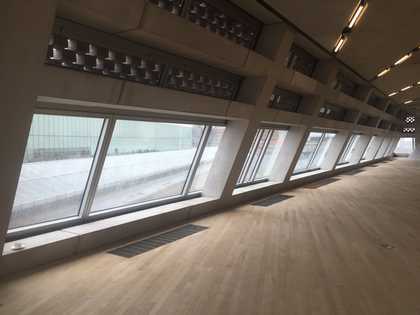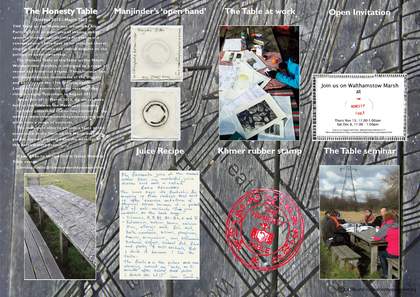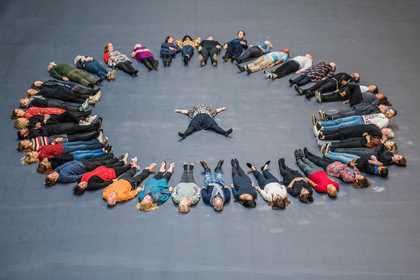
Members of the public form a circle around artist Tania Bruguera during the opening of Hyundai Commission: Tania Bruguera: 10,148,451 at Tate Modern, 2018
Guy Bell / Alamy Live News
CARA COURAGE Why is the idea of community important in the context of art? From a Tate perspective, our communities help us to see our collection in different ways. We have about 14 teams working with the community in some regard, and we recognise that this community isn’t homogenous: there’s huge diversity, so we have three different approaches to classifying or thinking about those communities.
We work with ‘communities of place’ across all of the Tate sites. Each has its own local community relations and projects. At Tate Modern, for instance, we have Tate Neighbours, formed as part of Tania Bruguera’s Hyundai Turbine Hall Commission. This is a group of people that either live or work within a five-minute walk of the gallery.
We also work with ‘communities of interest’. This might be a group with an interest in a particular type of art, in the museum itself, and that leads them to become a volunteer. And, finally, we work with ‘communities of impact’. These include Tate Collective, for instance, which is our young people’s membership with over 150,000 members, or the D/deaf community, whom we have worked with for a long time.
To return to the question of why community is important in the context of art: for us, as a museum, all of these groups are important. They are our neighbours, our partners, our collaborators. Tate Neighbours, in particular, are a ‘critical and loving friend,’ as they put it, to Tate: they poke at us and they interject. Like all of these communities, they are change agents.
SAM THORNE The idea of art making, and of cultural production in general, always implies some kind of community. It forms a community of sorts, even when that’s one consisting only of the maker, object and viewer. In its broadest sense, this might be a community that spans years, centuries or even millennia – an unfinished conversation that develops a kind of ever-forming community over space and time. For me, that’s what art does at its most basic level. It’s what it’s always done. So we could say that art both creates community and requires it, just as communities are required to create art. I’m particularly interested in the kinds of communities and support structures that create culture: Who gets a say in that? And who is that culture for?
QUINSY GARIO Community conversation has always been important to me. Until 2016, I was a lone wolf: I was able to attach myself to different communities and work within them. But in 2016, I became a board member for De Appel arts centre in Amsterdam. De Appel is a historically revolutionary space established in 1975. It has a rich history of nurturing artists who actively push against static notions of an art community, from the video and performance art it championed in the 1970s, to being at the forefront of the education turn with the launching of its Curatorial Programme in 1994 and its world renowned archive. Then, in 2016, it was confronted with a huge budget cut.
At this point, the new board was forced to rethink what De Appel means today. One of the things that we discussed was the notion of shrink as opposed to growth and our new director Monika Szewczyk has been thinking about wellbeing and art, now even more topical than before. We were questioning the way in which communities had become just another number for the visitor count. When the institution relocated from the centre of the city to the outer ring in Amsterdam Nieuw-West in 2017, what it means to go beyond the centre of Amsterdam became more central: how to be communal with marginalised voices, marginalised bodies, to think of travel and migration beyond the clichés.
In my own artistic practice, I’m interested in the conversations that we have within communities. I’m from Curaçao and Sint Maarten, which have been part of a fractured community in and of itself through the colonisation by the Dutch. Physical distance is often translated into cultural difference: how are we supposed to create a communal bond with a country that feels foreign but provides you with a European passport? All of these questions have become part of my thinking. How can I make my art in a way that does not necessarily build bridges but re-understands these links – historically, socially, culturally – and tries to ponder anew what would it mean to be communal?
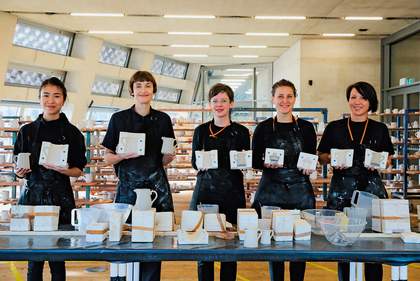
Participants in Factory: The seen and the unseen, a project by artist Clare Twomey (second from left) that transformed Tate Exchange into a factory making everyday objects from clay, 2017
Dinendra Haria / Alamy Live News
CC Following that, I think we should also flip our opening question: Why is the idea of art important to community? That’s something that I cannot take for granted at Tate Exchange. How do we make art relevant to them? And why should a community even care about art engagement?
ST Museums caring about community is arguably a fairly recent phenomenon. I would say that, even until the 1990s or 2000s, community was still regarded by many museums as something that happened ‘out there’. They called it ‘community outreach’ for a reason, right? So, this hub and spoke model, which has all kinds of colonial overtones and underpinnings, remained in place for a long time. Many would argue it still pertains. In museums, community was historically the province of education teams rather than exhibition curators. But in the last decade, there’s been a major shift: however belatedly, most museums have come to understand that communities are central to what they do. We see that with projects such as Bruguera’s and initiatives such as Tate Exchange. In the last decade, a number of major exhibitions have sought to trace the longer history of what we might call ‘socially engaged’ art or ‘social practice’, which have distinct yet interlinked histories. I’m thinking of exhibitions such as Living as Form, which Creative Time organised in New York in 2011, or the Van Abbemuseum’s Museum of Arte Útil, which Bruguera was involved with in 2013.
CC Yes, Bruguera’s ideas of spectators becoming equal participants in a civic space is central to my work. Whichever community we’re working with at Tate Exchange, however they might define themselves, they are the co-creators of that space. They are equal stakeholders: what is at stake if we don’t do this work? Because working with communities goes beyond any institutional social responsibility to a much deeper pedagogy: to the mission and vision of the museum, which blows open the idea of the museum as a civic space alone. A civic space has a set of parameters around it, and I think to bring the community in, you really need to agitate for those parameters to be questioned and pushed at.
QG I think in terms of bringing in the community, it’s also interesting to ask which types of communities we are entering into conversations with, particularly when thinking through the collecting of art by museums, and the collecting of anthropological art and ethnological art. How do we open up a conversation with new communities while also acknowledging those that already exist, of which we are already a part? Because, usually, this conversation happens outside, as we said before. People come in and then, right afterwards, they leave. How do we make sure that the community becomes part of the institution and that thinking about the community becomes part of the institutional logic?
CC I want to raise a red flag there, which shouldn’t be taken as a disagreement: I’m very conscious that when you bring a community in to any institution, the expectation is often on them to do the work of the museum. We need to ensure that these communities are not doing the emotional labour, that they are not doing the work the institution should be doing. This is an ongoing conversation between us and the Tate Neighbours: how we are interacting with our communities and how equitable those relationships are.
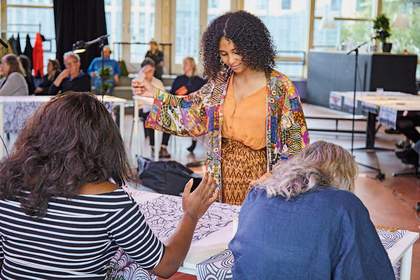
Visitors to De Appel, Amsterdam take part in a Stitch In sewing workshop led by artist Patricia Kaersenhout, 2019
Courtesy De Appel, Amsterdam, photo: Tarona Leonora
ST Perhaps this is a useful point to address the question of being good neighbours? For me, this involves thinking about your network. It means thinking about the voice you have, the power you have, the resources you have, and the ways in which certain spaces might be made available to others.
At Nottingham Contemporary, we think in terms of civic responsibility. Just about everything we do is in partnership. That’s how we are constituted. We want to move beyond what is expected from a contemporary art centre. For instance, we run a year-long independent studies programme called CAMPUS, of which Quinsy is one of the faculty members. It’s free to attend and we work with other arts organisations across the city to do it. We also have a project called Schools of Tomorrow. This sees us work with eight primary schools over the course of several years to think about how we might rethink the relationship between museums and schools, at a moment when, as we know, the arts are getting stripped out of curriculums.
It’s important to think about how we can continue to be a space of reflection, of exchange, of debate, while the spaces themselves get tighter, more constrained. For me, that goes some way towards defining being a good neighbour.
QG Responsibility is the important word. In my own work, I think about the good neighbour in terms of who is invited into a home. Who is the guest? What does it mean to be the guest? Does being a good neighbour mean entering into a transactional relationship, or is it enough to exist alongside one another, to be kind to one another, to be critical of one another?
That’s how I think when I work with others: we’re all living on the same ‘street’, as it were, so we have an equal responsibility. I’ve said no to projects because the work that needed to be done to make my own work possible hadn’t yet been done. But when you go into institutions that have that infrastructure in place, the emotional labour in place, it’s fascinating.
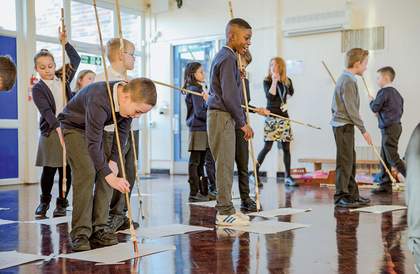
School children participate in a workshop at Milford Primary School, Nottingham, as part of Nottingham Contemporary’s Schools of Tomorrow programme
Courtesy Nottingham Contemporary, photo: Sam Kirby
CC Two things strike a chord there, Quinsy, with regards to Tate Exchange. You talk about the space we take up – at Tate Modern and Tate Liverpool, we take up space, literally. You can’t avoid us. This requires us to give a lot of thought to what happens around us, outside our walls. But you were also comparing neighbours to those whom you would invite into your home, and that’s exactly how I think about Tate Exchange and how we welcome people in as if it’s our home. The rules don’t change just because we’re an institution.
Our work with Tania reframed our thinking. It focused and sharpened the way that we understand ourselves as neighbours, and I have been considering this in relation to museums more generally. Museums respond to the human need for connection and, in that, we have a responsibility to hear our neighbours. We need to genuinely listen.
For Tate Neighbours, for instance, we are a meeting place, but we also provide a space for reflection and thought – one that they use on a daily basis. They use our space to protest as well: there was a local bus route closing and the group protested that closure in Tate Modern; when Tania was imprisoned, we protested about that as well.
QG That’s beautiful to hear. I think that it’s also important that, when we have these conversations about new communities, we also connect with the history that we’re building upon. I love historical research, so I’m always digging and always trying to understand the links or the questions or the connections that were made in the past but are no longer seen. In that sense, I also wonder what it would mean for Tate Exchange to think about the institution’s historic links to sugar plantations and the way that would push different types of conversation around colonial connections and decolonisation movements.
ST Following Quinsy’s prompt, perhaps we could talk about what lies behind some of the practices we’ve been discussing? This is a huge topic, but when I think about what is in the air right now, a lot of artists and educators continue to turn to texts like Paulo Freire’s Pedagogy of the Oppressed, which was published in the late 1960s in Brazil but became a touchstone for artists and organisers in the UK, the US and beyond when it was translated into English.
Around that time, a lot of the practices in North America that we might now call ‘social practice’ really had their roots in civil rights movements and community organising. At the same time in the UK, you could look to the history of radical community centres in East London, or to the Artist Placement Group. These are incredibly rich histories, some of which have only recently come into focus.
Personally, I often return to Group Material, a collective of artist-activists founded in New York in the late 1970s by the likes of Julie Ault and Félix González- Torres, and the work they were doing in the Lower East Side of Manhattan. They made exhibitions using works donated by the neighbours, always with a wry, critical edge. For me, Group Material has a legacy that a lot of us are still grappling with.
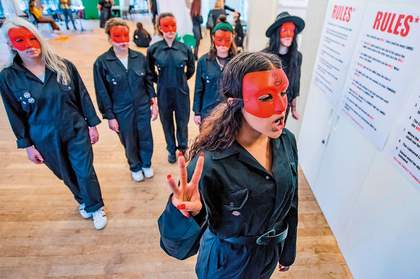
Students from Central Saint Martins present a live work titled Come Together at Tate Exchange, 2019
Guy Bell / Alamy Live News
QG In terms of thinking through legacies, we should also attend to the personal. One of the things that my own work has led me to consider is the way that, within my family alone, this notion of art and community has always been intertwined. My uncle Rudsel Martinus was
the head of the art teacher’s academy in Curaçao, where he prepared a new generation of thinkers, and my aunt Gala Martinus is giving after-school classes to kids right now, creating this huge community of kids, while also making her own art. My mum Glenda Martinus also shares this understanding of art as something beyond a solitary pursuit.

A cartoon strip about the Tate Neighbours group created for a workshop led by Tania Bruguera at Tate Exchange, 2018
Photo © Dan Weill Photography
There have also been associations of students and activists in the Netherlands who produced so much work in the 1970s and 80s, which we are still trying to figure out. There are archives and anecdotes in attics and basements that are yet to see the light of day. But you need to gain trust to do this, and I think that’s what’s been interesting for groups like The Black Archives in Amsterdam, for example. Miguel Heilbron, Jessica de Abreu and Mitchell Esajas became the intermediaries. You need to bring together the people who have the same type of logic but might not know each other, might not trust each other.
My work around Black Pete in the Netherlands [Zwarte Piet, the folkloric companion of Saint Nicholas who is often portrayed in Dutch Christmas parades by people wearing blackface, curly wigs and bright red lipstick] always also attempted to create a community, not around ethnicity or race but around intersections of oppression. How do we ensure that this conversation is inclusive without being exclusive? I think that’s what’s interesting and important about forming these communities: it should not be prescriptive.
ST Quinsy, I remember when you were talking about Black Pete in Nottingham, someone asked whether there was a danger of preaching to the choir. You had an illuminating response: ‘Well, sometimes the choirs need to be reminded how to sing the songs.’ I love the idea that an artist’s role might be to galvanise existing communities, to push them, to remind them, while also doing something completely new.
For more information on Tate Exchange see tate.org.uk/tate-exchange. Tate Exchange is supported by Maryam and Edward Eisler and Tate Patrons. With founding support from Freelands Foundation.
Cara Courage is Head of Tate Exchange at Tate Modern, Sam Thorne is Director of Nottingham Contemporary and Quinsy Gario is a visual and performance artist from Curaçao and Sint Maarten.

